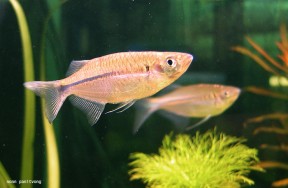Laubuka siamensis
SynonymsTop ↑
Laubuca siamensis Fowler, 1939
Etymology
Laubuka: from Layubuka, a vernacular Bengali name for L. laubuca, the type species of the genus.
siamensis: ‘from Siam’ [Thailand].
Classification
Order: Cypriniformes Family: Cyprinidae
Distribution
Native to the Mekong river system in Thailand, Laos, Cambodia, and Vietnam, the Chao Phraya and Mae Klong watersheds in central and western Thailand, and various smaller drainages in southern Thailand and Peninsular Malaysia, including the Tapi and Pahang basins in the latter.
Type locality is ‘Waterfall at Trang, Thailand’.
Habitat
Inhabits small tributary streams, freshwater pools, canals, rice paddies and other quiet water bodies, and is known to move into inundated forests during the wet season. It is invariably observed swimming in groups at or just below the water surface.
Maximum Standard Length
50 – 60 mm.
Aquarium SizeTop ↑
An aquarium with base dimensions of 120 ∗ 30 cm or equivalent should be the smallest considered.
Maintenance
This species will do well in most well-maintained larger aquaria but is best maintained in a set-up designed to resemble a slowly-flowing river or stream, with a substrate of variably-sized rocks, gravel and some large water-worn boulders.
This can be further furnished with driftwood branches, and aquatic plants such as Microsorum, Bolbitis or Anubias spp. can be grown attached to the décor. In this kind of environment it will display more natural behaviour and can be kept alongside other species that enjoy similar conditions.
Like many fishes that naturally inhabit running waters it’s intolerant to the accumulation of organic wastes and requires spotless water at all times in order to thrive. The aquarium must also have a tightly-fitting cover since this species is an accomplished jumper.
Water Conditions
Temperature: 20 – 28 °C
pH: 6.0 – 7.5
Hardness: 18 – 179 ppm
Diet
Naturally a surface feeder preying on terrestrial and aquatic invertebrates. In the aquarium it will accept dried foods of a suitable size but should also be offered live and frozen Daphnia, Artemia, chironomid larvae (bloodworm), etc., on a regular basis.
Behaviour and CompatibilityTop ↑
Not an aggressive fish and can be kept with many cyprinids, loaches, cichlids, catfish and characins, although as always when selecting a compatible community of fish proper research is essential.
It is a schooling species by nature and ideally should be kept in a group of at least 8-10 specimens which will not only make the fish less nervous but result in a more effective, natural looking display.
Sexual Dimorphism
Adult females are noticeably deeper-bodied and usually grow slightly larger than males.
Reproduction
Unreported.
NotesTop ↑
Considered synonymous with the congener L. laubuca for a number of years, thus reports of that species from anywhere in Indochina actually refer to the current concept of L. siamensis.
Given the distribution of L. siamensis, it seems likely that many of the fish entering the aquarium trade are also this species and not L. laubuca. The two species can be distinguished by colour pattern. L. siamensis possesses a black (iridescent blue in live specimens) midlateral stripe on the posterior portion of the body, which terminates in an oval-shaped (vs. roundish in L. laubuca) blotch on the caudal peduncle. There are a series of faint vertical markings in place of the stripe on the anterior portion of the body, and the humeral marking is vertically-oriented and not ocellated (vs. roundish and ocellated in L. laubuca).
In live specimens the posterior stripe in L. siamensis is conspicuously present and not interrupted by any vertical markings (vs. dark stripe less conspicuous, much thinner, and interrupted by irregular vertical markings along the entire body in L. laubuca).
The generic name tended to be spelled ‘Laubuca‘ for a number of years, but it is now established that Bleeker used ‘Laubuka‘ first, therefore this spelling has priority.
Among other cyprinids Laubuka species are closely related to the genera Chela, Malayochela, and Devario according to recent phylogentic research, which also supports the splitting of the fomerly much larger Chela grouping into Chela, Malayochela, and Laubuka. There is also a suggestion that L. dadiburjori is not a direct relative of other Laubuka species and may warrant placement in its own genus.
References
- Fowler, H. W., 1939 - Proceedings of the Academy of Natural Sciences of Philadelphia v. 91: 39-76
Zoological results of the third De Schauensee Siamese Expedition. Part IX - Additional fishes obtained in 1936. - Bănărescu, P. M., 1968 - Annali del Museo Civico di Storia Naturale `Giacomo Doria' v. 77: 53-64
Remarks on the genus Chela Hamilton-Buchanan (Pisces, Cyprinidae) with description of a new subgenus. - Fang, F., M. Norén, T.-Y. Liao, M. Källersjö and S. O. Kullander, 2009 - Zoologica Scripta 38(3): 237-256
Molecular phylogenetic interrelationships of the south Asian cyprinid genera Danio, Devario and Microrasbora (Teleostei, Cyprinidae, Danioninae). - Freyhof, J., D. V. Serov and T. N. Nguyen, 2000 - Bonner Zoologische Beiträge 49(1-4): 93-99
A preliminary checklist of the freshwater fishes of the River Dong Nai, South Vietnam. - Kottelat, M., 2001 - WHT Publications, Colombo: 1-198
Fishes of Laos. - Kottelat, M., 2013 - Raffles Bulletin of Zoology Supplement 27: 1-663
The fishes of the inland waters of southeast Asia: a catalogue and core bibiography of the fishes known to occur in freshwaters, mangroves and estuaries. - Kulabtong, S., S. Suksri and C. Nonpayom, 2012 - Biodiversity Journal 3(3): 159-164
New data of the freshwater fish genera Laubuca Bleeker, 1860 (Cypriniformes Cyprinidae) and Phenacostethus Myers, 1928 (Atheriniformes Phallostethidae) in Thailand. - Pethiyagoda, R., M. Kottelat, A. Silva, K. Maduwage and M. Meegaskumbura, 2008 - Ichthyological Exploration of Freshwaters 19(1): 7-26
A review of the genus Laubuca in Sri Lanka, with description of three new species (Teleostei: Cyprinidae). - Rainboth, W. J., 1996 - FAO, Rome: 1-265
FAO species identification field guide for fishery purposes. Fishes of the Cambodian Mekong. - Silas, E. G., 1958 - Journal of the Bombay Natural History Society 55(1): 54-99
Studies on cyprinid fishes of the oriental genus Chela Hamilton.





